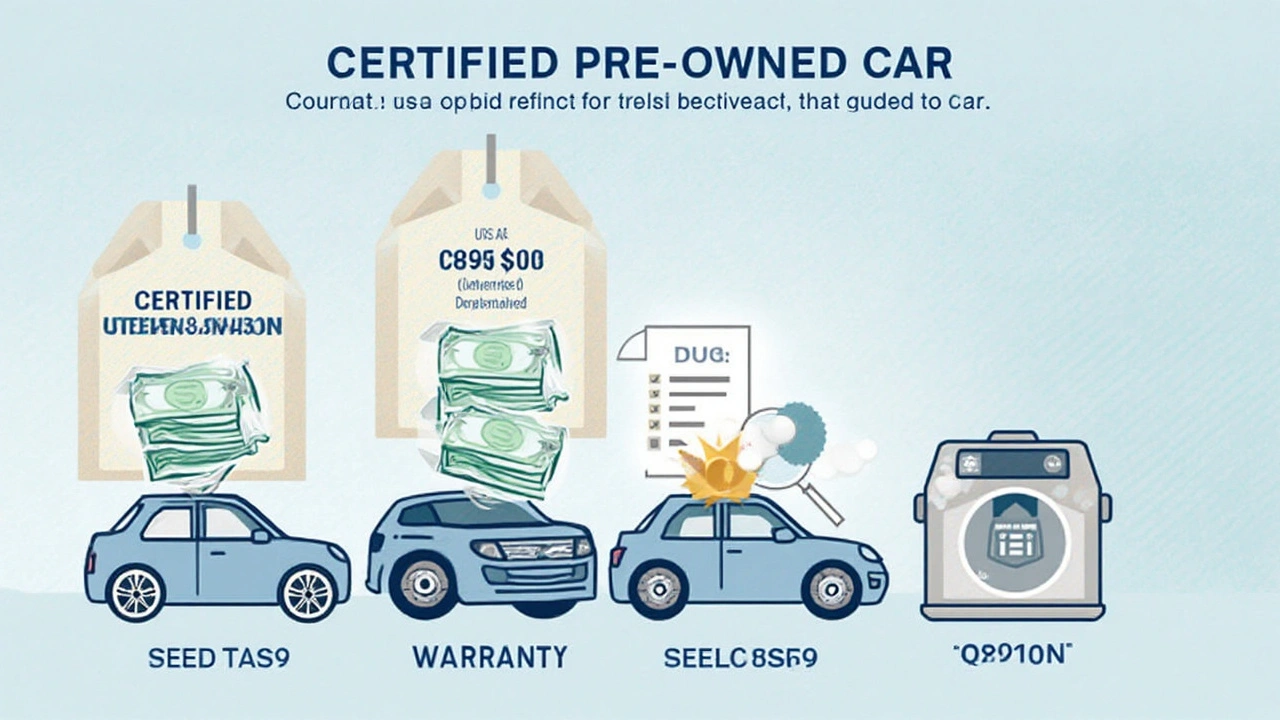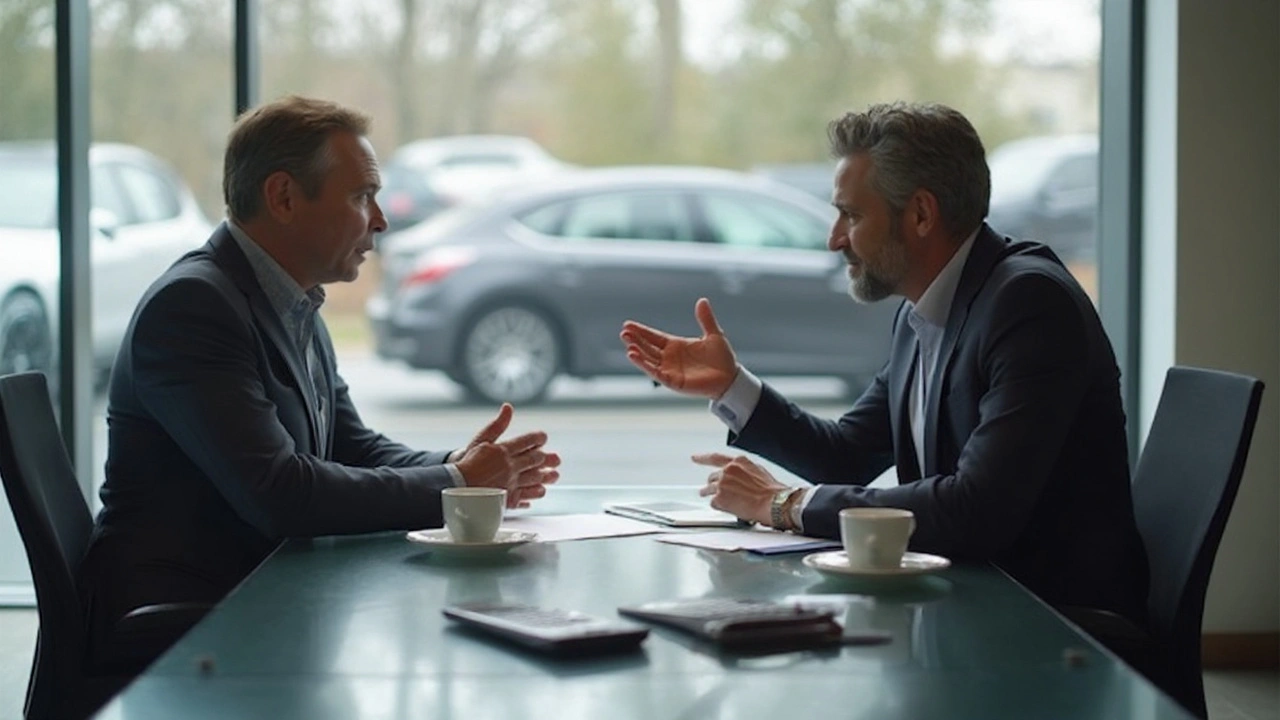Picture this: you walk into a dealership, past all the flashy new models, and spot a shiny car with a sign that reads 'Certified Pre-Owned,' or CPO for short. The salesperson starts talking about inspection points, extra warranties, and 'peace of mind.' But then you see the price tag and wonder—is it actually worth it? Should you pay that much more for a car that isn’t truly new? Let’s unpack what you get when you pony up for a certified pre-owned, what you should expect to pay, and how not to get ripped off in 2025.
What Makes a Certified Pre-Owned Car Different?
Let’s be honest: not all used cars are created equal. A certified pre-owned (CPO) car sits in that sweet spot between new and used. The difference isn’t just marketing—it comes down to standards, inspections, age, mileage, and perks. So what’s actually going on under the hood of the CPO label?
Manufacturers have pretty tight rules for certifying cars. Most require the car to be under five years old and have fewer than 60,000 miles (or about 100,000 km), though some luxury brands stretch those standards. Take BMW’s CPO, for example: cars can’t be over five years old or have more than 60,000 miles. Toyota sticks to a seven-year and 85,000-mile max. Dealers inspect each car—sometimes checking over 150 different points: brakes, tires, underbody, paint, and even whether the tech in the dash works. If something doesn’t meet the requirements, it’s fixed or the car doesn’t make the cut.
- Certified pre-owned cars come with manufacturer-backed warranties, so you usually get something like 12 to 24 months of coverage, with roadside assistance thrown in. That’s coverage you won’t get with the average used car purchase.
- The inspection point thing isn’t a myth. Honda, for example, shouts about its 182-point inspection. Mercedes-Benz boasts a 165-point check. It all sounds thorough—because, at least on paper, it is.
But here’s a fact that surprises most people: independent research by J.D. Power found that CPO cars, on average, have 25% fewer complaints from first-year owners compared to non-certified used cars. So, while the term 'certified' can feel like a marketing gimmick, the rigorous inspection processes do catch stuff you might miss.
How Much More Do Certified Pre-Owned Cars Cost?
Here’s where the rubber meets the road, or your wallet. The average certified pre-owned car in the UK costs about 8% to 15% more than a non-certified used car of the same year, make, and model. Across Europe, the jump varies by brand—luxury brands and newer models tend to demand the steepest premiums.
| Car Brand | Average CPO Price (2025, £) | Average Used Price (2025, £) | CPO Premium (%) |
|---|---|---|---|
| Ford Fiesta | £11,800 | £10,600 | 11% |
| BMW 3 Series | £24,300 | £21,600 | 13% |
| Toyota Aygo | £9,400 | £8,600 | 9% |
| Audi A4 | £26,200 | £23,000 | 14% |
| Nissan Qashqai | £16,500 | £15,200 | 9% |
But why pay the premium? That extra chunk gets you the manufacturer-backed warranty, a detailed inspection, and sometimes extra benefits like a free MOT, breakdown cover, or even servicing deals. For comparison, fixing a major issue like a failed turbo or transmission could easily cost more than the CPO price gap. I’ve heard from a local Bristol garage that the average transmission repair can run close to £1,500, so the idea of shifting that risk onto the manufacturer is honestly appealing for some buyers.
The sweet spot for value sits with mainstream makes, two to four years old. Cars younger than that and you creep up toward new car pricing, but anything older or with higher mileage rarely makes it into CPO programs anyway.

What Are You Getting for the Extra Money?
That all depends on what matters most to you. Are you after a stress-free ride with fewer repair headaches? Or do you just want the cheapest way from A to B?
The warranties are usually the big hook. Most CPO programs in the UK throw in a 12-month warranty, but if you’re looking at something like a Lexus or Mercedes, you could get two years. There’s also MOT cover (up to a certain amount), roadside assistance, and even exchange programmes if you discover a hidden problem. According to Auto Express Magazine, "The real benefit for CPO buyers is not just the inspection but the ability to walk away if the car doesn’t live up to expectations—usually within 30 days or 1,000 miles.”
The AA reports that over 70% of UK buyers say manufacturer-backed warranties played a 'major role' in their CPO purchase.
Another perk: CPO cars are usually the cleanest, best-kept ones on the used market. You’re less likely to inherit a dog’s breakfast of mechanical neglect or bad DIY repairs.
This protection isn’t perfect, though. Some wear-and-tear items (think wiper blades, brake pads, tyres) might not be covered, and minor cosmetic issues can slip through. Always ask for a written copy of what is and isn’t covered, because terms change between brands and even between dealerships. Don’t just take the salesperson’s word for it—get the inspection report and warranty book in your hand. I’ve lost count of friends who find out too late that their warranty only covers the engine, not the infotainment system that just started glitching.
Some sellers try to double up on the offering. They’ll upsell you on extended warranties or ‘paint protection packages’ at the point of sale. Know what’s actually in your package, what’s a manufacturer benefit, and what’s an add-on cooked up by the dealer for commissions.
How to Judge If a CPO Car Is Worth the Asking Price
This is the golden question. Are you actually getting value, or just paying for a logo and a shiny car wash?
- First, compare apples to apples. Get the model, year, trim, mileage, and condition, then search out comparable CPO and non-CPO listings. Parkers.co.uk, Auto Trader, and Honest John are great for UK benchmarks.
- Factor in any extras, like how many months of warranty remain, MOT status, servicing perks, and whether roadside cover applies nationally.
- Don’t assume all CPOs are flawless. I walked away from a supposedly certified Nissan Juke that looked great—until an RAC inspection revealed hidden accident damage missed by the CPO check.
- Bargain for extras, especially if you’re on the fence. Sometimes you can get the price down, especially at end-of-quarter when dealers are desperate to shift stock. Sometimes you can score free mats, fuel, or extra servicing instead.
- If the CPO car is barely cheaper than a new one—think 5% or less—ask yourself if stretching to new is a better move. New cars often have lower finance rates and sometimes come with grants or incentives, especially for electric cars.
- Don’t buy just because the word 'certified' sounds fancy. Ask for evidence, read everything, and question every fee. Even in 2025, used car scams happen. Data shows Britain’s SMMT reports about 1 in 15 used car buyers got burned with hidden defects in 2024, even in the CPO segment.
If you're in Bristol or anywhere in the UK, bear in mind trends can be regional. Some CPO programs are only available through official dealers, so you’ll pay a bit more in bigger cities, while rural dealerships may be more willing to haggle if the car has sat unsold for weeks.
Here’s a little table breaking down potential CPO benefits versus average repair costs, based on 2025 UK data:
| Benefit | Usual Value (Est.) | Average Cost if Paid Alone |
|---|---|---|
| 12-Month Warranty | £500-£1,000 | £800 |
| Roadside Assistance | £80-£120 | £110/year |
| Free MOT | £40-£60 | £55 |
| Servicing Credit | £100-£300 | £200 |

Smart Tips for Scoring the Best Deal on a CPO Car
You want a good car and a good deal, right? Here are battle-tested tips from Bristol car buyers and industry insiders that increase your odds of driving away happy:
- Time your purchase. The end of March, June, September, or December is gold—dealers are desperate to hit targets, so they’re more flexible. After new reg releases in the UK, trade-ins flood the market and CPO lots fill up. More choice equals better negotiation power.
- Ask about the previous owner. Was it a private car or a hire fleet? A single-owner CPO is usually better than one battered by rental customers.
- Request all paperwork. Inspection reports, service history, MOT records—don’t skip this. If there are gaps, walk away. Even well-known brands can have patchy records on lower-value CPO cars.
- Negotiate extras, not just price. If the sticker won’t budge, push for a longer warranty, extra servicing, or even a full tank of fuel. Dealers often have more wiggle room here than on the actual price.
- Check the fine print. Not everything is covered by that warranty, and 'wear and tear' is a vague term. Scrutinize the exclusions, check when major services are due, and factor in running costs—you don’t want to pay a premium for a car that needs £800 in brake work three months later.
- Trust but verify. Even with a CPO, get an independent inspection if you’re nervous or buying a more expensive model. Most dealers won’t object, and it can uncover issues missed or glossed over in the fast dealer checkover.
- Factor in finance options. CPO cars often come with better finance rates than regular used cars, but check total cost over the loan period, including any fees for early payoff. Some programs, especially for electric cars in 2025, have incentive deals or lower APRs.
- Check for manufacturer recalls. Some sneaky dealers slap a CPO badge on stock with outstanding recalls. Run the VIN through the DVLA recall checker yourself or ask the dealer to provide proof that fixes have been made.
The best deals often go to people who show up prepared. Research real prices, know what is and isn’t negotiable, and trust your gut if something feels off.
As of this week in June 2025, the UK CPO market is still strong, with waiting lists for the most popular hybrids and electrics. But the pandemic-fueled supply squeeze is slowly easing, so don’t let a salesperson pressure you with 'one day only' offers. Cars aren’t flying off the lot like they used to. Take your time, shop around, and make the CPO premium work for you, not the dealer.


Comments
Tyler Springall
Honestly, the whole idea of paying a premium for a certified pre-owned (CPO) car feels overrated to me. You’re basically buying a vehicle that’s already depreciated but paying more just because it comes with a manufacturer’s stamp of approval. It’s like paying extra for a "certificate" rather than actual value.
The article touches on differences between CPO and regular used cars, but I’d argue that many people just get duped by the fancy marketing. Why pay thousands more when a thorough independent inspection can achieve nearly the same peace of mind? The local trends in Bristol don’t make a dent in this universal principle.
That said, I appreciate the deep dive into negotiation mistakes. Dealers banking on people’s ignorance to maximize profit is nothing new, but the premade guide here is a handy weapon. Still, buyer beware — none of these tips will save you if you don't do your own homework.
July 18, 2025 at 03:18
Elmer Burgos
I think this article is spot on for folks eyeing a certified pre-owned car. It’s not just some glorified used car, there's real value in warranties and rigorous inspections that many don’t consider. Especially if you want peace of mind without the new car price tag.
True, the premiums can feel steep, but the article’s advice on timing and negotiation is gold. Sometimes patience and knowledge really pay off. Plus, learning about brand nuances helps you zero in on the best deals.
Living in the US, I can say some ideas translate well regardless of geography. Anyone else found local trends either align or differ wildly from what they read here?
July 18, 2025 at 09:26
Jason Townsend
Yall realize the whole CPO thing might just be another ploy by big auto companies to keep us all paying more than we should? I mean, CPO cars come from the same used car pool, right? But then they slap the label on and hike the price.
And don’t forget, dealers often have backdoor deals and inside info we’ll never see, skewing prices. Plus, how do we know these so-called "inspections" are legit? Smells like a racket to me. Just saying, be suspicious when someone tells you it’s "certified." Could be a trap.
July 18, 2025 at 17:46
Jennifer Kaiser
This article raised some excellent points about understanding what you're actually paying for when you get a certified pre-owned car. Many people conflate the premium with guaranteed quality, but it’s more nuanced.
The tips about timing negotiations and looking at the finer details of the warranty are really crucial. I believe anyone considering a CPO should also think about their own needs and risk tolerance rather than just trusting the label blindly.
Also, the attention to the UK market specifics adds valuable perspective. It reminds us that these factors can shift dramatically depending on locale.
Has anyone here had great or terrible experiences buying a CPO in their area that either supports or contradicts this?
July 18, 2025 at 23:20
Sara Escanciano
Can we stop glorifying certified pre-owned cars as if they’re the only option? The article even says there are brand differences and common mistakes, yet so many people unquestioningly pay the premium expecting perfection.
It’s irresponsible to blindly trust dealers who have massive incentives to oversell. Buyers have the agency to do due diligence and refuse to get ripped off. This "expert advice" feels like it tiptoes around the fact that the whole system is rigged in the sellers’ favor.
Let’s call it what it is: often a pricey gamble dressed up as security. If you’re serious about this, be aggressive, ask hard questions, and don’t settle for feel-good buzzwords.
July 19, 2025 at 02:06
TIARA SUKMA UTAMA
I think the key takeaway here is about being proactive and informed before making any decisions. The local insights from Bristol might seem niche but they add depth to how different markets behave. Negotiation timing, for example, varies way more than folks realize.
The article could have focused more on personal budgeting and breaking down how the premium affects long-term ownership costs, though. That’s something we often overlook in the heat of the buying process.
Anyway, I appreciate the concise breakdown, but still feel like there’s a lot people need to research for themselves no matter what car they’re eyeing.
July 19, 2025 at 07:40
Jasmine Oey
OMG finally someone airing out the myth of certified pre-owned cars being actual good investments! Like seriously, the so-called "premium" they charge is just the industry milking fools for every penny.
The article is very dramatic about "expert advice" but let’s not forget: 90% of buyers don’t negotiate properly and just throw money away. Plus, the brand differences they blab about? Overhyped marketing BS. You wanna know the truth? Most of these CPO cars are just slightly cleaner used cars with fancy badges slapped on.
Wake up, people! Research hard, don’t let dealers gaslight you into spending more than you should.
Also that UK insight was kinda interesting but honestly, money is money no matter where you live.
July 19, 2025 at 13:13
Marissa Martin
Reading this article, I felt it thoughtfully exposes the layered considerations behind certified pre-owned cars that many buyers overlook. It’s complicated: the warranty benefits, local market trends, and negotiation tactics all factor in differently depending on who you are.
It’s refreshing to see advice that encourages people to weigh what they value most— is it peace of mind, lower upfront cost, or brand reputation? Too often, folks rush into CPO deals because of external pressure, which isn't helpful.
I’d love to hear more stories from others on how their personal values shifted their buying choices.
July 19, 2025 at 16:00
Antwan Holder
The whole certified pre-owned selection feels like a metaphor for so many things in life — the illusion of perfection while hiding imperfections beneath. We pay for a label, hoping it masks reality, but sometimes it only amplifies our insecurities about making the right decision.
This article scratched the surface well, pointing out price differences and brand distinctions, but I wonder about the human psychology behind why we succumb to paying these premiums in the first place.
What if this is less about the car and more about our need for certainty in an uncertain world? Deep stuff, I know. But it’s worth pondering next time you’re face-to-face with a dealer.
July 19, 2025 at 21:33
Angelina Jefary
I have to admit, this post made me paranoid about the whole certified pre-owned thing more than reassured me. They detail prices and warranties but what about the tiny print and the loopholes that dealers sneak in?
Grammar wise, the article is neat but I caught myself rereading the warranty section because it glosses over exceptions. Always remember, a warranty doesn’t mean unconditional coverage; it’s a legal maze, folks.
Anyone who’s been through shady CPO deals knows that the devil’s in the details. Never sign anything without reading every single clause under a magnifying glass. Stay alert.
July 20, 2025 at 05:53